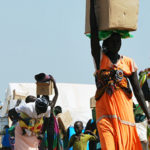There is very little evidence on what role donors can play in making political settlements more horizontally inclusive. The state of research on this area remains theoretical and not empirical, although there is a clear normative consensus that international actors need to consider inclusivity in political settlements. The three areas of inquiry in this report (political ...» more
Social Development
Comprehensive sexuality education
Comprehensive sexuality education (CSE) has strong support in the international discourse, and is supported by a relatively robust evidence base. In general, the evidence suggests that CSE has positive impacts on behaviour change, such as increased condom use, girls’ empowerment and delayed sexual debut. This is achieved through increasing knowledge and changing attitudes. ...» more
Gender and conflict
What do we know about the role of gender inequality in producing or exacerbating the structural causes of violence and conflict, and about the multi-layered effects of violence and conflict on gender relations? What do we know about how to support gender equality in fragile and conflict-affected situations (FCAS)? This Topic Guide introduces the research evidence. ...» more
Gender responsive budgeting
Gender responsive budgeting (GRB) brings together two issues that are not commonly associated with one another: gender equality and public financial management. GRB argues that gender equality principles should be incorporated into all stages of the budget process. GRB initiatives seek to improve the results of budgets in general, and gender equality and women’s empowerment…» more
Wellbeing through empowerment, improved enabling environment, and assets
The literature is very clear that economic factors are critical to wellbeing. Almost all research states the necessity of income, financial security or productive assets. Nearly all the literature also looks at personal relationships as aspects of wellbeing, which are here categorised as part of the enabling environment. Empowerment is usually seen as agency, the ability to ...» more
Jobs, unemployment and violence
(This 10-minute presentation accompanying the reading pack was recorded at the GSDRC Seminar on Conflict and Development, London, 23 March 2015.) The notion that unemployment is a strong probable cause or motivating factor behind violence and violent conflict is remarkably pervasive in international development. It is believed that unemployment triggers participation in insurgencies, prompts people…» more
Horizontal inequalities
(This 15-minute presentation accompanying the reading pack was recorded at the GSDRC Seminar on Conflict and Development, London, 23 March 2015.) Civil wars are one of the main sources of state fragility, low incomes and poor human development. Hence, policies to prevent conflict must be a high priority for those concerned with promoting development in…» more
Women’s networks in MENA
There is a large number of women’s networks in the region, ranging in size and influence. Grassroots networks exist alongside high-level political and policy networks. Most are focused on women-only activities. The key areas of activity are: improving women’s entrepreneurship and developing women as business owners and business leaders; peacebuilding; reducing violence ...» more
Lessons from Female Engagement Teams
Evaluations of Female Engagement Teams (FETs) used by the military to engage with women in Afghanistan that are available indicate that: Female soldiers have had a deescalating effect as Afghan males generally accepted females being searched as long as it was done by other females. FETs have had positive engagement with both women and men and were viewed as a kind of ‘third ...» more
Examples of PFM impacts on gender equality
Research for this report was unable to find conclusive cases where public financial management (PFM) reform led to impacts on gender equality. This is because PFM reform does not necessarily lead to gender equality impacts, and conversely improvements in gender equality do not always require, or follow on from, PFM reform. It may also be that gender impacts are rarely covered ...» more
Inclusive growth
Absolute poverty has fallen substantially over the last 30 years, with most of this reduction attributable to rapid economic growth in developing countries. Yet growth often does not meet the needs of the poor. Economic growth in the absence of measures to ensure the sustained equitable distribution of its benefits has frequently perpetuated the concentration of wealth in the ...» more
Impact of cash and asset transfers on child and forced marriage
There are very few programmes that have directly tried to tackle forced and early marriage through cash or asset transfers. Of the programmes that have, many are fairly recent or are small-scale, making it difficult to assess long term impacts or draw lessons (Sinha and Young 2009). Some cash and asset transfer programmes have indirectly impacted on child and forced marriage ...» more
What is social protection?
Concepts and definitions Social protection is concerned with protecting and helping those who are poor and vulnerable, such as children, women, older people, people living with disabilities, the displaced, the unemployed, and the sick. There are ongoing debates about which interventions constitute social protection, and which category they fit under, as social protection ...» more
Design and implementation
This section provides links to key manuals, guidance and other practical resources. General manuals Devereux, S. (2008). Innovations in the Design and Delivery of Social Transfers: Lessons Learned from Malawi. IDS and Concern Worldwide. See full text Grosh, M., del Ninno, C., Tesliuc, E. & Ouerghi, A. (2008). For Protection and Promotion: The Design and Implementation ...» more
Vulnerable groups: needs and challenges
Women and girls It is often women who require social protection interventions, as they are disproportionately vulnerable due to lack of capital, high wage differentials and gendered work norms, bearing the responsibility for childcare, and exclusion from basic services. Social assistance programmes, particularly conditional cash transfers, are often aimed at women as the ...» more
Policy objectives and evidence of impacts
Social protection can have a wide range of objectives and impacts, from food security, access to services, gender equality, and state-building, to social transformation. The emphasis in developing countries has been on poverty and vulnerability reduction, and human development, for which there is good evidence. There is less evidence on longer-term developmental impacts such as ...» more
Global issues and debates
Page contents Coverage, scale and systems Financing and affordability Political economy Targeting Conditionalities Shocks and risks Fragile and conflict-affected states State-building Coverage, scale and systems The last 15 years have seen a huge increase in social protection programmes, both the number of programmes and number of countries which have ...» more
Types of social protection
Social assistance Social assistance is direct, regular and predictable cash or in-kind resources transfers to poor and vulnerable individuals or households (Arnold et al., 2011: 91). It is usually provided by the state and financed by national taxes (Barrientos, 2010). Support from donors is also important in lower income contexts. Transfers are non-contributory, i.e. the full ...» more
Social policy
The development of social policy as a discipline is associated with the emergence of welfare states in European countries. This reading guide provides the user with some key texts and narrative. The development of European countries involved the progressive extension of rights, civil rights in the 18th century, political rights in the 19th century, and…» more
Gender in development
Gender inequality matters to development for two reasons. First, it is a justice problem. Ideologies of women’s inferiority are used to justify serious human rights abuses including female infanticide, child marriage, female genital mutilation, sexual violence, and deprivation of equal access to health care, education, property, employment and pay. Second, gender inequality is developmentally inefficient….» more



